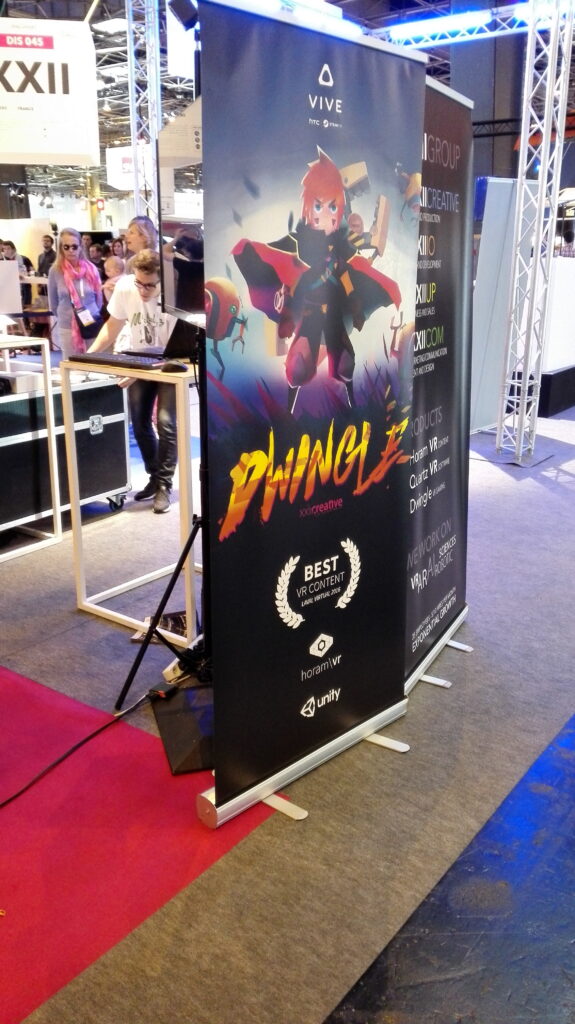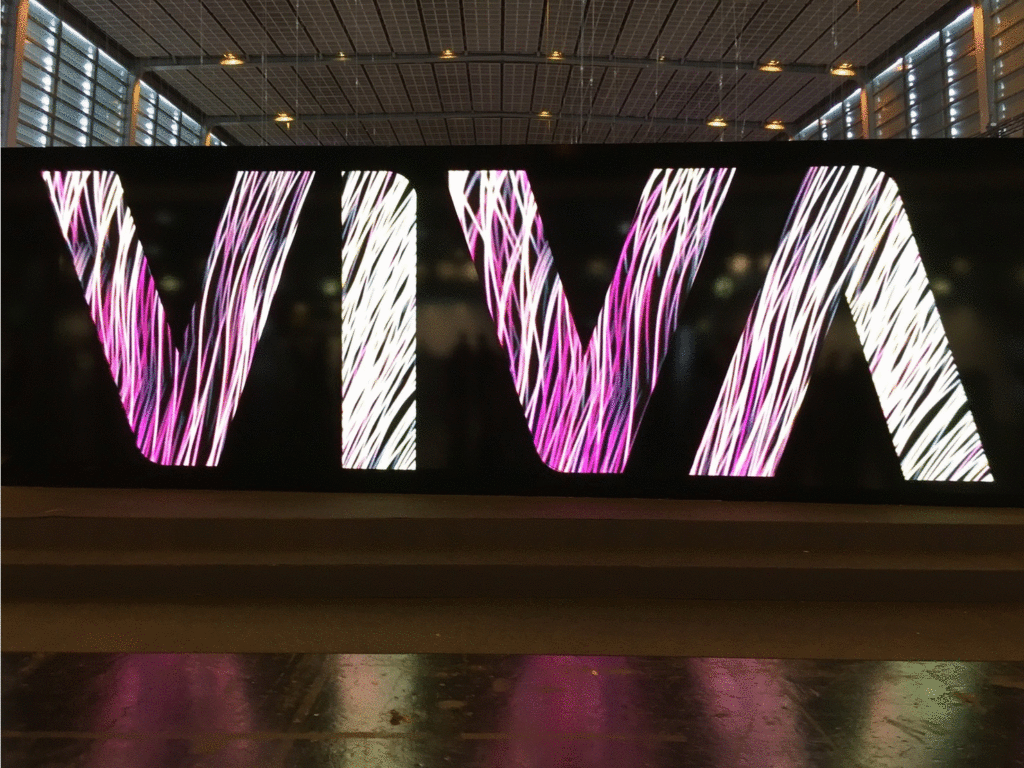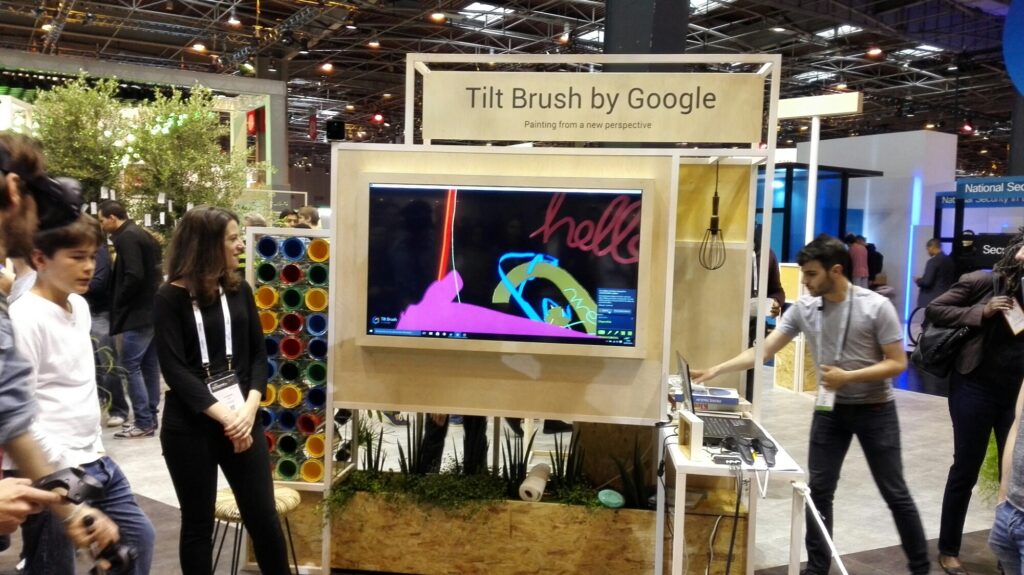Members of the Creative Technology Foundation visited the Viva Tech Paris exhibition and tested several virtual reality solutions.
Tilt-brush
Tilt brush is a drawing game based on total immersion in virtual reality. A kind of very improved 3D light painting.
The user is equipped with an HTC Vive headset and 2 joysticks allowing him to express himself.
The first joystick gives access to a multifunction menu where you choose your brushes, the color palette, the filling options and others. The second joystick is used for painting.
Getting started takes some time. The menu gives access to many options, so you can easily get lost. However, the experience is well worth it.
The user begins to draw what he has in mind, in 3D. Finally the experience begins…! The most impressive thing is to be able to move in 3D in relation to his drawing.
The possibilities quickly become endless. The only limit is the human imagination.
This application very quickly became more than a game. Professional designers and illustrators like Glene Keane have made it a creative tool.
We have also fallen for this game at UX-Republic since our acquisition of the Htc Vive headset!
[youtube https://www.youtube.com/watch?v=GSbkn6mCfXE&w=560&h=315]
The pros:
- One of the best immersive experiences
- Endless possibilities
The - :
- Handling a little complicated
leap-motion
The Leap motion company is currently working on the Orion project.
The Orion project allows people who have a Leap motion + a Rift occulus to control virtual reality objects with their hands. During the viva technologie, we were able to test this project.
Here is our feedback on this project:
The pros:
- Better immersion thanks to leap motion. No more joysticks, objects are directly manipulated with bare hands.
- A feeling of freedom
The - :
- Leap motion and headphones are plugged into a computer
See the Orion project:
[youtube https://www.youtube.com/watch?v=rnlCGw-0R8g&w=560&h=315]
To download Orion in beta version: https://developer.leapmotion.com/orion
PlayStation VR
Formerly called Project Morpheus and announced since 2014 by Sony, it is the natural competitor of the Oculus Rift and the HTC Vive.
VR headset for the general public, it is the first headset for new generation game consoles (8th). With a fleet of machines (PlayStation 4) of around 40 million units, it is probably the VR tool that has the greatest potential.
Sony promises usan immersive experience in virtual reality accessible and fun for the general public.
The kit consists of a PlayStation VR, a PlayStation Camera and an audio headset for optimal immersion. The kit, sold from autumn 2016 at €400.
The helmet has an OLED screen with a resolution of 960×1080 pixels per eye, a 3-axis gyroscope and an accelerometer. It connects to the PS4/processing unit via HDMI and USB cables.
The experience, which lasts about 10 minutes, allows you to dive into a crevasse in a protective cage.
What makes <span style="font-family: 'arial black', 'avant garde';">inlingua</span> different
- Experience is very immersive
- Image quality
- Restitution of user movements (PlayStation Camera in addition to internal sensors)
The -
- The sensation is only visual
- Wired headset that limits freedom of movement
Skylight
Skylight is a VR technology that uses a Samsung Gear and a smartphone to watch 3D movies.
Skylight wants to be immersive in the film because we no longer see what surrounds us: headphones isolate ambient noise. The idea is good but we had a bad experience on this project. In fact, during the demonstration, the 3D films weren't really playing (we felt like we were watching a classic film), and the screen was very small! There was a black background that filled in the absence of the film on the entire screen.
Dwingle on Htc vive
The HTC Vive is one of the most successful headsets we've been able to test. Unlike its competitors on the market, the helmet is accompanied by two controllers to be able to interact with the environment and two "base stations" which are motion sensors, a play area of approximately 3m2 is required.
We were able to test the “dwingle” game, created by XXII Creative, a French studio. The purpose of the demonstration was to find different parts of a robot in a workshop and build it.

After a few seconds of adjusting the headphones to have a good quality image, we find ourselves in total immersion, we forget that we are in the middle of a living room. The game controllers allow you to interact with the elements of the decor in our case drawers, boxes, collect the parts of the mini robot and build it.
Of course, you have to move to reach these different elements, hence the importance of having a large free space even if the playing area remains delimited in the helmet by the appearance of a virtual grid when you are at the edge of the playing area.
Video link:
https://youtu.be/Z3ca8mmgxOQ&w=560&h=315
To conclude:
The pros:
- Very good immersion
- Interaction via controllers
The - :
- The headset has a lot of cable
- You must install and be in the sensor area to use the helmet
Antoine Duplouy, UX-Master @UXRepublic
STORYTELLING: THE ART OF CONVINCING # Paris
SMILE Paris
163 quay of Doctor Dervaux 92600 Asnières-sur-Seine
UX/UI ECO-DESIGN # Paris
SMILE Paris
163 quay of Doctor Dervaux 92600 Asnières-sur-Seine
DESIGN THINKING: CREATING INNOVATION # Belgium
UX-REPUBLIC Belgium
12 avenue de Broqueville - 1150 Woluwe-Saint-Pierre
MANAGING AND MEASURING UX # Paris
SMILE Paris
163 quay of Doctor Dervaux 92600 Asnières-sur-Seine
DESIGN SPRINT: INITIATION & FACILITATION # Paris
SMILE Paris
163 quay of Doctor Dervaux 92600 Asnières-sur-Seine
UX-DESIGN: THE FUNDAMENTALS # Belgium
UX-REPUBLIC Belgium
12 avenue de Broqueville - 1150 Woluwe-Saint-Pierre
GOOGLE ANALYTICS 4 #Paris
SMILE Paris
163 quay of Doctor Dervaux 92600 Asnières-sur-Seine
ACCESSIBLE UX/UI DESIGN # Belgium
UX-REPUBLIC Belgium
12 avenue de Broqueville - 1150 Woluwe-Saint-Pierre














